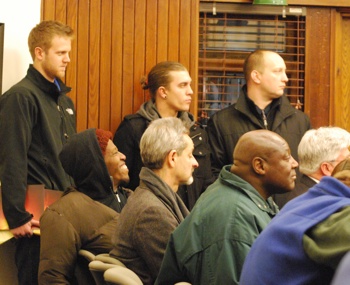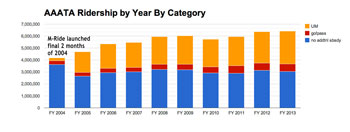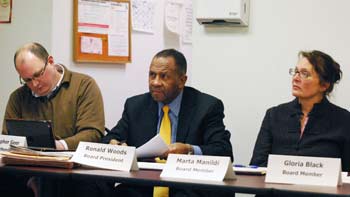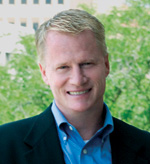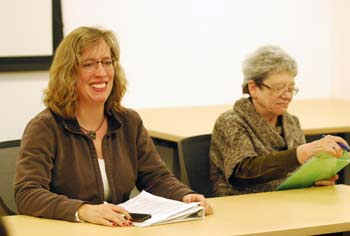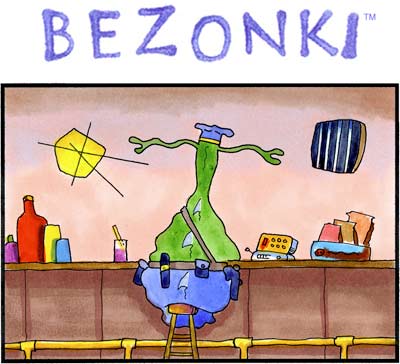Rotary to Fund Universal Access Playground
Ann Arbor park advisory commission meeting (Jan. 28, 2014): Park commissioners got news at their most recent meeting that the Rotary Club of Ann Arbor is making a $250,000 contribution to the city of Ann Arbor for a major new “universal access” playground at Gallup Park, to celebrate the club’s centennial anniversary in 2016.

From left: Bernie Lugauer and Bob Buckler of the Rotary Club of Ann Arbor talk with Christopher Taylor, an ex officio member of the Ann Arbor park advisory commission. (Photos by the writer.)
After a presentation on Jan. 28, commissioners recommended that the city apply for a state Dept. of Natural Resources grant to help fund the remainder of the work, which is estimated to cost $500,000.
Colin Smith, the city’s parks and recreation manager, told commissioners that although there are about 80 playgrounds in Ann Arbor, none are universally accessible. It’s a “huge shortcoming” for the parks system, he said. The exact location within Gallup Park hasn’t been determined, but the playground would be about 5,000 square feet and exceed the requirements of the Americans with Disabilities Act (ADA). The design and equipment is intended to create environments that can be used by all people, with features like ramps, color-contrasting structures, wider bridges and walkways, and playground equipment that makes it easier for people using wheelchairs.
Two Rotary representatives attended the Jan. 28 meeting to help describe the club’s role in the project. Bob Buckler, a Rotary director and co-chair of the group’s centennial committee, told commissioners that in general the Rotary’s primary focus is on supporting children, by funding scholarships, Washtenaw Success By Six and other programs. That’s why the universal access playground is so appealing as a way to celebrate Rotary’s centennial, he said. Buckler indicated that fundraising for this project has already begun. The grand opening is expected to be on Labor Day in 2016.
In other action on Jan. 28, commissioners approved the location for new tennis courts at Windemere Park – a project that’s been in the works for about two years. The location has been somewhat controversial among neighbors, and prompted a review of the previously selected site. The current courts have deteriorated and are in a location where it’s unsuitable to rebuild.
Also on Jan. 28, PAC recommended the purchase of two vans to keep up with the increasing shuttle transportation demands for Huron River trips in 2013, following the opening of Argo Cascades.
The meeting marked a transition of members on PAC. It was the first meeting for David Santacroce, who was appointed by the city council last year to replace Julie Grand. And it was the final meeting for Jen Geer, who has resigned after less than a year on the commission. Paige Morrison was appointed by the council on Feb. 3 to fill the remainder of Geer’s term – through May 19, 2016. [Full Story]




